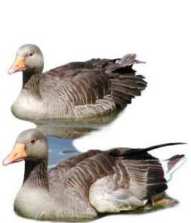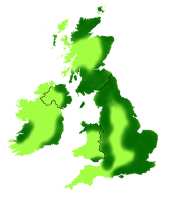|
Photography
|
Greylag Goose Plate | ||||
|
|
|||||
| Distinguishing Features |  |
||||
| Height 80cm (31in), Back is brown/grey barred plumage, orange bill with white tip. Pink leg. | |||||
| Food | |||||
| Vegetarian grazing on grass, seeds, roots floating vegetation. | |||||
| (Anatidae) anser anser |
|||||
|
|
|||||
 |
Nesting | ||||
| Between April and May. Clutch of 4 to 6 eggs, off white in colour.. Incubation appx 28 days. Eggs tended by female, nestlings tended by both parents. | |||||
| Habitat | |||||
|
Fresh water lakes, lochs and reservoirs. |
|||||
|
The darker green on the map above indicates
where you are most likely to see a Greylag Goose..
|
|||||
|
|
|||||
| Other information | |||||
|
Native to Northern Scotland, the Greylag Goose has been introduced to many parts of the British Isles and is thriving. Further identification shows five black bars on its neck, which is attributed to ridges of feathers. The nest is built near water and consists of mounds of local vegetation. Lined with feathers, they can be found nesting close to each other in colonies. Visiting migatory birds from Iceland swell the local population in Scotland making them unpopular with farmers as they will eat seed and root crops. Powerful in flight flocks can seen in 'V' formation or a line formation. |
|||||
| [Home] [News] [Gallery] [Birds] [Discover] [About] [Contact] [Members] | |||||